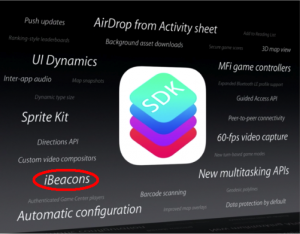Beacons: Part 1 – Technology
Published on
June 12, 2014
By Brian
User Experience Architect
Just over a year ago, Apple introduced iOS7 and, for those who paid very close attention, iBeacons. It wasn’t mentioned at all in the keynote, but only appeared inconspicuously on a single slide shown that day.

“With iBeacon, Apple Is Going to Dump on NFC and Embrace the Internet of Things” by Hari Gottipati, gigaom.com.
To be clear, “iBeacons” is Apple’s own name for the technology, and, as frequently happens, that name has popularly come to refer to all “beacon” technology. Since the technology itself is not proprietary to Apple, I’ll be using the term “beacon” to refer to the technology.
Beacons are a proximity detection technology that allow an individual’s smartphone to be aware of nearby beacons. Since its inauspicious introduction, it has become widely regarded as a game-changing technology, with great potential to engage customers.
With the speculation that took place between its announcement and actual availability, there has been a lot of confusion about this technology. Early adopter implementations have only scratched the surface of what is possible. More creative implementations require an understanding of its capabilities and limitations.
How Beacons Work
A beacon is a small device that is constantly transmitting a unique ID that other nearby devices can detect. The communication is one way, i.e., the beacon cannot detect your phone.
For your phone to do anything with the ID being received, it has to have an app installed that is listening for the type of ID being transmitted. An app made to listen to beacons in Store A is essentially deaf to beacons installed in Store B, and vice versa.
Once a related app receives an ID that it is listening for, it then has to determine what that ID means. Typically, apps designed to use beacons are designed in conjunction with cloud services where information related to each beacon ID can be retrieved.
In addition to serving up the latest information related to the visitor’s location, those cloud services can also collect information. At a minimum, the installed app would, along with the ID, send a unique ID representing that specific device, allowing for various analytics to be recorded.

If the app requires the user to log in, then the information gathered can be used to build a marketing profile for that user. When combined with data about that user’s online activity, physical and online targeting and personalization are possible.
The Technology
Beacons use a recent iteration of Bluetooth called Bluetooth Low Energy (BLE). As the name implies, “Low Energy” is a key part of this technology. A single watch battery can power a beacon for months. Similarly, your phone uses very little energy listening for BLE beacons. The technology wouldn’t be so promising if everyone disabled it on their phones because of battery drain.
Various beacons
Beacons can also be tiny, not much bigger than a quarter. In fact, one of the first uses of the technology was in keychain fobs and coin-sized beacons that would help users locate commonly lost items.
The average cost is around $50 per beacon, so a large number of them can be deployed economically. Which is important because, while the devices can be detected up to 30 meters away, actual distance detected is typically very inconsistent. The lack of accuracy is such that it is typically broken down into far (2 to 30 meters), near (0.5 to 2 meters) and immediate (less than half a meter). Generally, the closer you are to a beacon, the more accurate the distance calculation.
This brings us to the one major misunderstanding about how beacons can be used. They are not a true positioning system. They are a proximity system. Your device only knows roughly how far you are from a beacon. It doesn’t know if you are standing in front of, behind or beside the beacon. There are many articles out there that were written before these limitations were widely known. Many of these articles mention the ability to use triangulation, or trilateration, to compute an accurate location when multiple beacons are detected. Given the technology’s lack of distance accuracy, this type of computed location can only be relied upon to give very general information. For example, it could be used to determine on which side of a display someone was standing, but not their exact location.
In Part 2 of this post, we will review various applications of beacon technology.